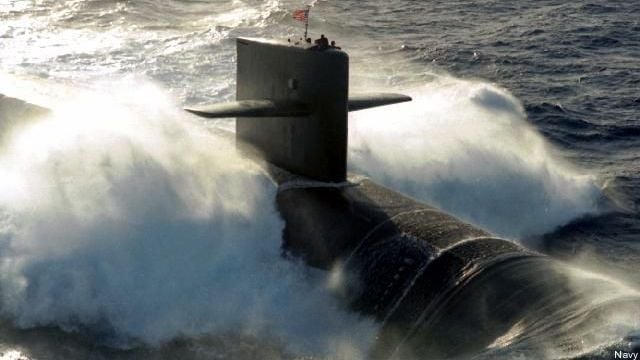‘My Last Ship Was Older Than I Was’: Sailor Quizzes SecDef On New SSBNs
Posted on

An Ohio-class ballistic missile submarine.
KINGS BAY NAVAL SUBMARINE BASE, GEORGIA: Defense Secretary Chuck Hagel came here Wednesday to celebrate the Navy’s nuclear deterrence force. But just 20 minutes in, a petty officer second class stood up in front of almost 200 of his comrades and pointed out the $95 billion elephant in the room: Can the Navy afford to buy the next generation of ballistic missile submarines?
Today’s Ohio-class SSBNs are most important leg of the nuclear triad: Under the New START arms control treaty, the subs are slated to carry 70 percent of the nation’s deployed nuclear warheads. But “they’re starting to kind of show their age,” the sailor told Hagel. “My last ship was older than I was.”
“This is World War II technology with modern electronics,” said Capt. William Houston, commander of the SSBN squadron here, as he slapped the periscope on the 27-year-old USS Tennessee. (Ohio-class periscopes use physical mirrors; the newer Virginia-class attack subs have video cameras). Even with their service life extended to an unprecedented 42 years – so long that accumulated metal fatigue on the hull will become a crucial limit – the Ohio SSBNs will have to start retiring in 2027.
Design of a new Ohio Replacement Program submarine (formerly SSBN-X) is already underway. “Yes, it’s forcing us to make some hard choices in our budget, but I’ve been clear on this, the president’s been clear on this,” Hagel told the auditorium full of sailors. “We continue to be committed to a new generation of [ballistic missile] submarines.”
This month, however, the Navy officially acknowledged to Congress it can’t afford to build it.
Overall, the Navy’s 30-year shipbuilding plan “requires funding at an unsustainable level, particularly between FY25 and FY34,” says the unusually blunt report. For once, the problem is not the automatic budget cuts known as sequestration, which will be finished by the mid-2020s. Instead, the issue is the sheer cost of the Ohio Replacement Program. The report continues, “the DON can only afford the SSBN procurement costs with significant increases in our top-line or by having the SSBN funded from sources that do not result in any reductions to the DON’s resourcing level.”
“It is good that the Navy is at least acknowledging what we’ve been saying for a number of years now,” groused Rep. Randy Forbes, chairman of the House Armed Services subcommittee on seapower, when I spoke to him Tuesday. “The bad side is that what we’ve been saying for a number of years now is still true, and the Navy really hasn’t taken any steps to fix that.”
Forbes’ solution, endorsed by both the House and Senate Armed Services Committees, involves setting up a special fund to pay for the Ohio Replacement Program outside the regular Navy budget. But “finding a different account to fund it through is more or less a budget gimmick,” said Todd Harrison, the fiscal guru at the influential Center for Strategic and Budgetary Assessments. “It’s coming out of DoD’s budget somewhere. So how are you going to pay for it?”
All of this that we’re doing is only a first step,” Forbes acknowledged. “If you’ve ever opened a savings account when you were young, you know that opening it was a step, but you still had to discipline yourself to put money in.” But just as opening a savings account shows you’re at least trying to save, creating an Ohio Replacement Program account indicates Congress is at least acknowledging the need to meet the massive expense, and that’s “a huge deal,” he said.
But who pays? If you leave the Navy budget the same and fund the new SSBN outside it, “this effectively gives the Navy a larger budget share,” said Harrison.
So be it, said Rep. Forbes. “The Navy cannot continue to decrease in size [and] that turnaround will of necessity mean more dollars going into that account,” he said. “We’re not talking about colossal changes here. We’re talking about 1 to 1.5 percent of the budget.”
Even such marginal shifts in budget share are bitterly fought over between the four armed services, but “it’s not without precedent,” Harrison told me. “You don’t have to go back that far to see the kind of shift in the base budget we’d be talking about here,” he said. “In the drawdown toward the end of the Vietnam conflict” – our last long, brutal land war – “we saw a major shift in budget share where the Navy got a lot more [and then] maintained a slightly larger share of the budget than the other services through out the ’80s and ’90s.”
Such a shift is politically possible because the changes can occur gradually, Harrison added. “You don’t have to get Congress to agree to it outright,” he said. “It’s something that would happen incrementally year by year over time.”
With the Ohio replacement budget building gradually from today’s design and development efforts to the beginning of construction in 2021, “there is time to deal with it,” Harrison said. “The point right now is to start having that discussion of how are we going to make this fit.”
Subscribe to our newsletter
Promotions, new products and sales. Directly to your inbox.
